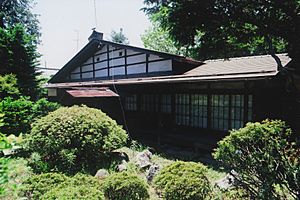Takeo Takei facts for kids
Quick facts for kids
Takeo Takei
|
|
|---|---|
| Born | June 25, 1894 Nagano Prefecture, Japan
|
| Died | February 7, 1983 (aged 88) Tokyo Prefecture, Japan
|
| Nationality | Japanese |
| Known for | Illustration for children |
Takeo Takei (武井 武雄, Takei Takeo, 25 June 1894 – 7 February 1983) was a famous Japanese artist. He is best known for creating amazing illustrations for children's books.
Takeo Takei is one of Japan's most important children's illustrators from the 1900s. He was among the first to make really good quality pictures for kids. He believed in creating art that respected and helped a child's imagination grow. Even today, nearly 100 years after his first works, his art still inspires many things. You can see his influence in illustrations, manga, animation, computer games, and even advertisements.
Contents
Takeo Takei's Life Story
Takeo Takei was born on June 25, 1894, in Hirano-village, Japan. This place is now called Okaya-city. He was the first and only child of Kei-ichiro and Sachi Takei.
Early Childhood and Art
Takei was a very artistic child. He drew his first picture when he was just three years old. He spent a lot of time alone at home because he was often sick. When he was in second grade, he only went to school for two weeks! During this time, he spent hours drawing and writing. He even imagined a fairy friend named "Mito" and played with her in his mind. This part of his childhood helped him understand how important a child's imagination is.
His father, who was the mayor of their village, first didn't want him to become an artist. But later, he gave Takei his blessing. Takei then went to the Tokyo Art School. Today, this school is known as the Tokyo University of the Arts. It's a top art school in Japan. He studied Western-style art and painting there. He finished his studies in 1919.
Starting His Career
In 1922, Takei's artwork appeared on the very first cover of a new children's magazine. It was called Kodomo no kuni (Children's Land). This magazine was very important. It published art, songs, craft ideas, and stories for children until 1944. The magazine believed in a new way of teaching children. It focused on individual ideas and freedom. This matched Takei's own beliefs about children's education.
Takei created a lot of art in the 1920s. He wrote and illustrated his own stories. He also illustrated Japanese folktales. He worked on other original fairy tales by Japanese writers, like Kenji Miyazawa. He even illustrated stories from other countries. For example, he drew pictures for "The Thousand and One Nights." In 1928, he illustrated the famous fairy tales by Hans Christian Andersen.
In 1927, Takei helped start a group called the Nihon Doga Kyokai. This was the Japan Association of Illustration for Children. At different times in his career, he also helped choose illustrations for various magazines. Sadly, much of Takeo's original artwork was lost. It was destroyed by fire in Tokyo during World War II.
Takeo Takei's Artworks
Takeo Takei's works can be put into three main groups. The first group is his illustrations for children, called "Doga" in Japanese. The second group is his woodblock prints, known as "Hanga." The third group is his special handmade books, called "Kanpon."
Illustrations for Children (Doga)
Takei used watercolors, crayons, and pen and ink for his drawings. His illustrations were often fantastical and dreamlike. But they were always easy for children to understand and enjoy.
In 1926, Takei published one of his most famous books. It was called "Ramu-Ramu O" (King Ramu-Ramu). Two years later, in 1928, he published "Dōbutsu no Mura" (The Animal Village).
Woodblock Prints (Hanga)
These are artworks made by carving a picture into a block of wood. Then, ink is applied to the block, and it's pressed onto paper. Takei created many beautiful woodblock prints.
Special Handmade Books (Kanpon)
The word Kanpon literally means "published book." Takei used this term for his own special books. He explored how creative and expressive a book could be. He made books using many different materials and unique designs. Learn more about Kanpon
Takeo Takei's Childhood Home
The house where Takeo Takei lived until he was 19 years old is still standing. It is in Okaya, Nagano Prefecture, Japan. This house was built in 1698 or 1699. That means it is over 300 years old! It was once a home for a samurai. Very few samurai homes from that time are still around. This is because they were usually made of wood and paper.
In 2008, the Okaya-city municipal office became the owner of the house. They decided to tear it down. However, many people disagreed with this decision. They started a social movement to save the house. They want to keep it as an important cultural treasure for everyone to enjoy.
Takeo Takei Museum
There is a special museum dedicated to Takeo Takei. It is called The ILF Doga Museum. It opened in 1998 in Okaya, Nagano. The museum collects and displays original illustrations. You can see Takeo Takei's children's book art there. They also show works by other artists, like Maurice Sendak.




